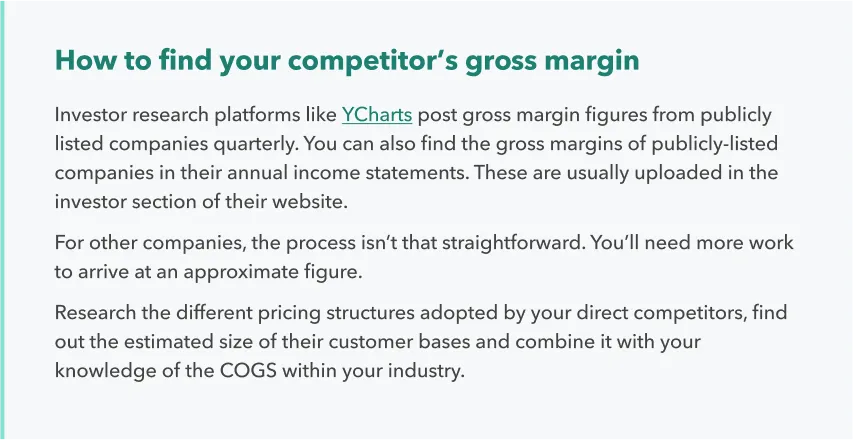Summary
The gross margin ratio is an essential start-up metric. Investors and founders use it to determine a company’s value. On the one hand, it shows how profitable a start-up is, and on the other hand, it allows for easy comparison with competitors and industry standards.
What is gross margin?
Gross margin refers to the profit a company makes after the goods are sold, considering the direct costs of materials and labour used to produce these goods.
Gross margin is expressed in percentage terms, primarily useful when comparing profit with peers.
To calculate your company’s gross margin, you need revenue figures and the costs of materials and labour that went into the production of your goods, also known as the Cost of Goods Sold (COGS).
Gross margin is also commonly referred to as gross profit margin or gross margin ratio.
How to calculate gross profit margin?

Gross margin only takes into account direct costs. These costs are specific to production activities, such as equipment, materials and labour.
Indirect costs aren’t part of the calculation. You will incur indirect costs, such as insurance, quality assurance and legal fees, even if the production of goods stops.
An example of gross margin
Candy Kingdom, a fictitious confectionery company, reported a total revenue of 3,000,000 USD in 2020. Their COGS added up to 1,900,000 USD (600,000 USD on materials and 1,300,000 USD on labour).
As a result, their gross profit for 2020 was 1,100,000 USD (total revenue - COGS), and the gross margin was 36.7% (Gross profit ÷ Total revenue x 100).
Why do gross margins matter?
Looking at your gross margins over time is a reliable way to assess your business’s sustainability because it tells you if the demand for your product outweighs its production costs.
Your gross margins over a specific period are useful to determine the effectiveness of your marketing efforts, pricing strategies and production costs.
If your business has more than one product, observing your gross margins helps you understand which products are in demand or underperforming.
Ultimately, the higher the gross margins, the more cash a company has on hand for indirect costs and investment in future growth.
What’s a reasonable gross margin for start-ups?
A gross margin of 30% seems to be the average. However, don’t focus too much on this number. There is a wide disparity in gross margins achieved by different sectors. Nike, for example, has a gross profit margin of 44.8%, while Walmart reported a 24.3% ratio in 2021 (via www.statista.com).
For start-ups, this information isn’t always readily available, though, and it will likely be lower than industry averages.
New start-ups may experience lower gross margins than their peers since they offer discounts to capture new business. Moreover, they aren’t at a stage where they can enjoy economies of scale.
Besides, if you’re looking to grow quickly, you’ll hire more people to produce and sell your product or service. And every new employee lowers your margins.
Therefore, it’s not advisable to compare ideal gross margins with larger and more mature businesses.
The bottom line: Find out the average gross margins of your competitors and strive to do better. But don’t forget your company’s scale influences the margins.

Why do investors care about gross margin?
Gross margins show how much money a company has after producing and selling its goods.
Increasing gross margins indicate a company consistently brings in more money. This can be used to cover other costs such as debt and business expansion.
Decreasing gross margins indicate a company needs to reassess its production costs and pricing structure.
Since this metric shows a company’s profitability and operating efficiency, investors use it to value a company and make investment decisions.

FAQ
What’s the difference between gross margin and profit margin?
Gross margin only considers direct costs, while profit margin takes into account direct and indirect costs.
Gross margin measures a company’s ability to generate revenue from direct costs related to producing goods. Profit margin goes deeper to investigate if revenue growth translates into increased profitability.
What is net profit margin?
The terms profit margin and net profit margin are interchangeable. Net profit margin measures the percentage of profit that remains after deducting direct and indirect costs from the total revenue.
How to calculate profit margin: [(Total revenue - Total expenses) ÷ Total revenue] x 100
What’s the difference between gross margin and gross profit?
Gross margin is expressed in percentage terms, while gross profit is expressed in a fixed amount.
Gross profit = Revenue - COGS
It’s more insightful for starting companies to use gross margins when comparing against industry benchmarks. Even if a company is recording high revenues, its gross margins will be expressed in proportion to its revenue and COGS. Using gross profit is only relevant for comparisons against peers that operate at the same pace and size.
Recap
Gross margin is a meaningful metric regardless of a company’s size. On the surface, it tells if the business is profitable or not.
But it’s also helpful to compare yourself with industry benchmarks and strive for cost optimisation.
In these two ways, investors determine if your company is investment-worthy.







.webp)
.png)

%201.webp)


.webp)